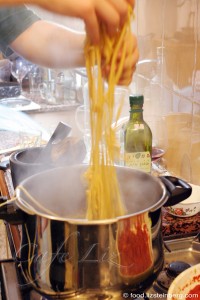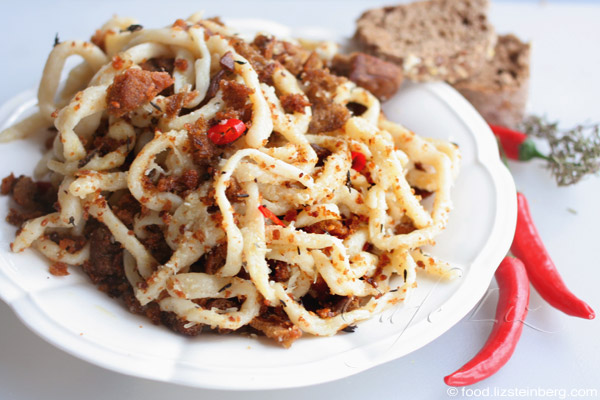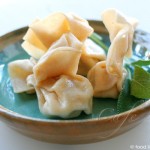
The next best thing to going to Italy and learning to make pasta from an Italian mother is having your cousins go and then teach you. (And the next best thing after that — hopefully — is learning about it on my blog.)
Paul was my friend before he became my cousin — my cousin-in-law, really. I suppose I’m to blame for that, because I’m the one who introduced him to my cousin, and they haven’t separated since. Eitan calls it all a nefarious, complex plot to make Paul into a relative — they married a pair of cousins and became cousins themselves.
So it was that my friend became a cousin, and it so happened that my cousins spent two weeks in Tuscany, touring the countryside and scouring for excellent food. One of the super-regional dishes there is pici — fat, hand-rolled noodles, long and uneven, and somewhat reminiscent of udon, which make an excellent foil to rustic sauces such as a garlicky tomato sauce or fried breadcrumbs.

In the village of Torrita de Siena in the Montepulciano region, the proprietor of the home they rented brought over a friend who showed them how to make the dish. Susanna would make the dish every Sunday for her family to eat for the week, heading into the kitchen in the morning and spending the day rolling out ribbons of dough with them.
The night my cousins arrived, we, too, whipped up a large mound of silky dough and then spent the next several hours slicing off strips and twirling them out into strands. We made more than we thought we could eat, yet we somehow finished it all.


To serve four:
- 500 grams type 00 flour — pasta flour
- 2 eggs
- 1 tablespoon olive oil, plus more for your hands
- 100-150 grams water
- lots of corn meal for dusting
Prep time: 1 hour. Cook time: 10 minutes.
Note: You’ll want a large work surface, such as an entire tabletop, because the noodles can get very long. A video of the process follows.
Pour the flour onto your work surface or into a bowl, and make a well in the center. Crack the eggs into it, beat them and start incorporating some of the flour into the eggs — you should keep your well structure. As you incorporate more flour and the dough begins to get stiff, add the olive oil and then the water, bit by bit. Your goal is a soft, elastic dough with the consistency of playdough — I probably used about 110 grams of water, but the exact amount will depend on how humid your flour is.
Once you have a shaggy lump of dough and all the flour has been incorporated, turn the dough out onto your work surface and knead well — 5 to 10 minutes. You want the dough to be silky smooth, because you’ll be stretching it out by hand. It’s good if you have people around to talk to while you knead.
Dust your work surface with cornmeal, put the dough on top of it and roll it out until it’s a bit less than a centimeter (half an inch) thick.
Slice off a 1-cm/half-inch strip from the flattened dough. Oil your hands lightly. If you’re right-handed, pin down the center of the strip with your left hand and start rolling the right tip of it with your right hand. (If you’re left handed, do the opposite.) The dough should go from rectangular to round and it should start rolling. If it doesn’t, you can give it a head start by rolling it between your two palms.
Work your way down the strip of dough — rolling it with your right hand until it’s about half a centimeter (1/4-inch) thick, and moving your way to the left as the dough stretches out.
When you’re done with the noodle — it’s OK if it breaks into shorter noodles — dust generously in cornmeal and set out on a flat surface. Try not to pile them too high on top of each other, because they’ll get stretched out as you try to lift them.
Repeat with the rest of the dough.
Bring a pot of salted water to a rolling boil, add the pici and cook for 5-10 minutes — longer than most fresh pasta, because they’re thick. The cornmeal should wash off the pasta during the cooking. Taste as you go, and once they’re al dente, drain, toss with sauce and serve.
For the breadcrumb sauce (briciole):
- 4 cups stale bread (180g)
- 1/2-3/4 cup olive oil, plus more if needed
- 1 tablespoon thyme leaves, preferably fresh
- 1 hot pepper, cut into thin discs
- 100 grams (1/2 cup) grated cheese (pecorino di pienza/siena, or Parmesan/another hard, aged cheese)
- salt
- black pepper
Prep time: 5 minutes. Cook time: 3 minutes.
Pulse the bread in a food processor until you have crouton-sized crumbs no larger than large pebbles. Pour 1/2 cup of olive oil into a pan, and toss in the thyme and 5-6 rings of hot pepper. Heat — the thyme should release its smell, and the pepper will turn dark brown.
Once the oil is aromatic, toss in the bread and stir well to coat. Add more oil if you need it to coat the bread. Fry so that the bread becomes brown and crunchy, but not burnt.
Toss in the pasta, the cheese and the black pepper. Depending how salty your cheese is, you may want to add salt.
Top with a few more slivers of red pepper and/or thyme leaves for color.
For the garlicky tomato sauce (aglione):
- 1/4 cup olive oil
- about 12 garlic cloves
- 1 800-gram can peeled tomatoes (that’s the original recipe, though I’d use fresh, peeled tomatoes instead)
- salt and pepper to taste
- fresh chopped parsley
- grated, aged Italian cheese
Prep time: 2 minutes. Cook time: 15 minutes.
Heat the olive oil, and dump the garlic cloves whole into the pan. Smash them against the side of the pan with a spoon — this becomes easier once they’ve cooked and softened somewhat.
Add the can of tomatoes and let simmer for 10-15 minutes until it has a rich flavor. Add a pinch of salt and pepper, toss with the pasta and serve sprinkled with parsley and/or cheese.




